Nb–Ta Behaviour during Magma-to-Pegmatite Transformation Process: Record from Zircon Megacrysts in Pegmatite
Abstract
:1. Introduction
2. Geological Background
3. Methods
3.1. SIMS Zircon U-Pb Dating
3.2. SIMS Zircon Oxygen Isotopic Analysis
3.3. LA-ICP-MS Zircon Hf Isotopic Analysis
3.4. LA-ICP-MS Trace Elements Analysis
4. Results
4.1. Trace Elements Composition of Zircon Megacrysts
4.2. Timing Evolution of Zircon Megacrysts
4.3. Hf-O Isotopic Characteristics of Zircon Megacrysts
4.4. Petrological Characteristics and Trace Elements Composition of Marginal Zone
4.5. Trace Elements Composition of Rutile in Marginal Zone
5. Discussion
5.1. Closed Mgmatic Evolution System
5.2. Nb–Ta Behaviour from Magma to Pegmatite Melt
5.3. Nb-Ta Fractionation Caused by Crystallization Differentiation
5.4. Nb-Ta Marker of Transformation from Magma to Pegmatite Melt
6. Conclusions
Supplementary Materials
Author Contributions
Funding
Acknowledgments
Conflicts of Interest
References
- London, D.; Morgan, G.B. The pegmatite puzzle. Elements 2012, 8, 263–268. [Google Scholar] [CrossRef]
- Černý, P.; London, D.; Novak, M. Granitic pegmatites as reflections of their sources. Elements 2012, 8, 289–294. [Google Scholar] [CrossRef]
- Stepanov, A.; Mavrogenes, J.A.; Meffre, S.; Davidson, P. The key role of mica during igneous concentration of tantalum. Contrib. Mineral. Petrol. 2014, 167, 1009. [Google Scholar] [CrossRef]
- London, D. Granitic pegmatites: An assessment of current concepts and directions for the future. Lithos 2005, 80, 281–303. [Google Scholar] [CrossRef]
- Zhu, Y.S.; Yang, J.H.; Sun, J.F.; Wang, H. Zircon Hf O isotope evidence for recycled oceanic and continental crust in the sources of alkaline rocks. Geology 2017, 45, 407–410. [Google Scholar] [CrossRef]
- Belousova, E.; Griffin, W.; O’Reilly, S.Y.; Fisher, N. Igneous zircon: Trace element composition as an indicator of source rock type. Contrib. Mineral. Petrol. 2002, 143, 602–622. [Google Scholar] [CrossRef]
- Stern, R.J.; Johnson, P. Continental lithosphere of the Arabian Plate: A geologic, petrologic, and geophysical synthesis. Earth Sci. Rev. 2010, 101, 29–67. [Google Scholar] [CrossRef]
- Krienitz, M.-S.; Haase, K. The evolution of the Arabian lower crust and lithospheric mantle—Geochemical constraints from southern Syrian mafic and ultramafic xenoliths. Chem. Geol. 2011, 280, 271–283. [Google Scholar] [CrossRef]
- Morag, N.; Avigad, D.; Gerdes, A.; Harlavan, Y. 1000–580Ma crustal evolution in the northern Arabian-Nubian Shield revealed by U–Pb–Hf of detrital zircons from late Neoproterozoic sediments (Elat area, Israel). Precambrian Res. 2012, 208-211, 197–212. [Google Scholar] [CrossRef]
- Stern, R.J.; Hedge, C.E. Geochronologic and isotopic constraints on late Precambrian crustal evolution in the Eastern Desert of Egypt. Am. J. Sci. 1985, 285, 97–127. [Google Scholar] [CrossRef]
- Jackson, N.J. Petrogenesis and evolution of Arabian felsic plutonic rocks. J. Afr. Earth Sci. 1986, 4, 47–59. [Google Scholar] [CrossRef]
- Beyth, M.; Stern, R.J.; Altherr, R.; Kröner, A. The Late Precambrian Timna igneous complex, Southern Israel: Evidence for comagmatic-type sanukitoid monzodiorite and alkali granite magma. Lithos 1994, 31, 103–124. [Google Scholar] [CrossRef]
- Be’eri-Shlevin, Y.; Katzir, Y.; Whitehouse, M. Post-collisional tectonomagmatic evolution in the northern Arabian-Nubian Shield: Time constraints from ion-probe UPb dating of zircon. J. Geol. Soc. 2009, 166, 71–85. [Google Scholar] [CrossRef]
- Stacey, J.S.; Hedge, C.E. Geochronologic and isotopic evidence for early Proterozoic crust in the eastern Arabian Shield. Geology 1984, 12, 310–313. [Google Scholar] [CrossRef]
- Windley, B.F.; Whitehouse, M.J.; Ba-Bttat, M.A.O. Early Precambrian gneiss terranes and Pan-African island arcs in Yemen: Crustal accretion of the eastern Arabian shield. Geology 1996, 24, 131–134. [Google Scholar] [CrossRef]
- Johnson, P.R.; Fayek, H.K. The Geology of the Saudi Arabian Shield; King Fahd National Library Cataloging; Saudi Geological Survy Press: Jeddah, Saudi Arabia, 2012. [Google Scholar]
- Johnson, P.R.; Kattan, F.H. Lithostratigraphic revision in the Arabian shield: The impacts of geochronology and tectonic analysis. Arab. J. For. Eng. 2008, 33, 3–16. [Google Scholar]
- Sláma, J.; Košler, J.; Condon, D.; Crowley, J.; Gerdes, A.; Hanchar, J.; Horstwood, M.; Morris, G.; Nasdala, L.; Norberg, N.; et al. Plešovice zircon—A new natural reference material for U-Pb and Hf isotopic microanalysis. Chem. Geol. 2008, 249, 1–35. [Google Scholar] [CrossRef]
- Li, X.H.; Liu, Y.; Li, Q.L.; Guo, C.H.; Chamberlain, K.R. Precise determination of Phanerozoic zircon Pb/Pb age by multicollector SIMS without external standardization. Geochem. Geophys. Geosyst. 2009, 10, 1–21. [Google Scholar] [CrossRef]
- Li, X.H.; Long, W.G.; Li, Q.L.; Liu, Y.; Zheng, Y.F.; Yang, Y.H.; Chamberlain, K.; Wan, D.F.; Guo, C.H.; Wang, X.C.; et al. Penglai zircon megacrysts: A potential new working reference material for microbeam determination of Hf–O isotopes and U–Pb age. Geostand. Geoanal. Res. 2010, 34, 117–134. [Google Scholar] [CrossRef]
- Li, X.H.; Tang, G.Q.; Gong, B.; Yang, Y.H.; Hou, K.J.; Hu, Z.C.; Li, Q.L.; Liu, Y.; Li, W.X. Qinghu zircon: A working reference for microbeam analysis of U-Pb age and Hf and O isotopes. Chin. Sci. Bull. 2013, 58, 4647–4654. [Google Scholar] [CrossRef]
- Wu, F.Y.; Yang, Y.H.; Xie, L.W.; Yang, J.H.; Xu, P. Hf isotopic compositions of the standard zircons and baddeleyites used in U–Pb geochronology. Chem. Geol. 2006, 234, 105–126. [Google Scholar] [CrossRef]
- Blichert-Toft, J. The Hf isotopic composition of zircon reference material 91500. Chem. Geol. 2008, 253, 252–257. [Google Scholar] [CrossRef]
- Gain, S.E.M.; Greau, Y.; Henry, H.; Belousova, E.; Dainis, I.; Griffin, W.L.; O’Reilly, S.Y. Mud tank zircon: Long-term evaluation of a reference material for U-Pb dating, Hf-isotope analysis and trace element analysis. Geostand. Geoanal. Res. 2019, 43, 339–354. [Google Scholar] [CrossRef]
- Anczkiewicz, R.; Oberli, F.; Burg, J.P.; Villa, I.M.; Günther, D.; Meier, M. Timing of normal faulting along the Indus Suture in Pakistan Himalaya and a case of major 231Pa/235U initial disequilibrium in zircon. Earth Planet Sci. Lett. 2001, 191, 101–114. [Google Scholar] [CrossRef]
- Pearce, N.; Perkins, W.; Westgate, J.; Gorton, M.; Jackson, S.; Neal, C.; Chenery, S. A compilation of new and published major and trace element data for NIST SRM 610 and NIST SRM 612 glass reference materials. Geostand. Geoanal. Res. 1997, 21, 115–144. [Google Scholar] [CrossRef]
- McDonough, W.; Sun, S.S. The composition of the Earth. Chem. Geol. 1995, 120, 223–253. [Google Scholar] [CrossRef]
- Černý, P.; Ercit, T.S. The classification of granitic pegmatites revisited. Can. Mineral. 2005, 43, 2005–2026. [Google Scholar] [CrossRef] [Green Version]
- Geisler-Wierwille, T.; Schaltegger, U.; Tomaschek, F. Re-equilibration of zircon in aqueous fluids and melts. Elements 2007, 3, 43–50. [Google Scholar] [CrossRef]
- Kusiak, M.A.; Dunkley, D.J.; Slaby, E.; Martin, H.; Budzyn, B. Sensitive high-resolution ion microprobe analysis of zircon reequilibrated by late magmatic fluids in a hybridized pluton. Geology 2009, 37, 1063–1066. [Google Scholar] [CrossRef]
- Bindeman, I.; Gurenko, A.; Carley, T.; Miller, C.; Martin, E.; Sigmarsson, O. Silicic magma petrogenesis in Iceland by remelting of hydrothermally altered crust based on oxygen isotope diversity and disequilibria between zircon and magma with implications for MORB. Terra Nova 2012, 24, 227–232. [Google Scholar] [CrossRef]
- Bindeman, I.; Valley, J. Low-δ18O rhyolites from Yellowstone: Magmatic evolution based on analyses of zircons and individual phenocrysts. J. Petrol. 2001, 42, 1491–1517. [Google Scholar] [CrossRef] [Green Version]
- Muehlenbachs, K.; Andersonjr, A.; Sigvaldason, G. Low-O18 basalts from Iceland. Geochim. Cosmochim. Acta 1974, 38, 577–588. [Google Scholar] [CrossRef]
- Dhuime, B.; Hawkesworth, C.; Cawood, P. When continents formed. Science 2011, 331, 154–155. [Google Scholar] [CrossRef] [PubMed]
- McGuire, A.; Stern, B. Granulite xenoliths from western Saudi Arabia: The lower crust of the late Precambrian Arbian-Nubian Shield. Contrib. Mineral. Petrol. 1993, 114, 395–408. [Google Scholar] [CrossRef]
- Vervoort, J.; Patchett, P.J.; Albarède, F.; Blichert-Toft, J.; Rudnick, R.; Downes, H. Hf-Nd isotopic evolution of the lower crust. Earth Planet Sci. Lett. 2000, 181, 115–129. [Google Scholar] [CrossRef]
- Vervoort, J.; Patchett, P.J.; Blichert-Toft, J.; Albarède, F. Relationships between Lu-Hf and Sm-Nd isotopic systems in the global sedimentary system. Earth Planet Sci. Lett. 1999, 168, 79–99. [Google Scholar] [CrossRef]
- Morag, N.; Avigad, D.; Gerdes, A.; Belousova, E.; Harlavan, Y. Crustal evolution and recycling in the northern Arabian-Nubian Shield: New perspectives from zircon Lu–Hf and U–Pb systematics. Precambrian Res. 2011, 186, 101–116. [Google Scholar] [CrossRef]
- Burnham, A.D.; Berry, A.J. Formation of hadean granites by melting of igneous crust. Nat. Geosci. 2017, 10, 457–461. [Google Scholar] [CrossRef]
- Thomas, J.B.; Bodnar, R.J.; Shimizu, N.; Sinha, A.K. Determination of zircon/melt trace element partition coefficients from SIMS analysis of melt inclusions in zircon. Geochim. Cosmochim. Acta 2002, 66, 2887–2901. [Google Scholar] [CrossRef]
- Nardi, L.V.S.; Formoso, M.L.L.; Müller, I.F.; Fontana, E.; Jarvis, K.; Lamarāo, C. Zircon/rock partition coefficients of REEs, Y, Th, U, Nb, and Ta in granitic rocks: Uses for provenance and mineral exploration purposes. Chem. Geol. 2013, 335, 1–7. [Google Scholar] [CrossRef]
- Bachmann, O.; Dungan, M.A.; Bussy, F. Insights into shallow magmatic processes in large silicic magma bodies: The trace element record in the Fish Canyon magma body, Colorado. Contrib. Mineral. Petrol. 2005, 149, 338–349. [Google Scholar] [CrossRef] [Green Version]
- Burnham, A.D.; Berry, A.J. An experimental study of trace element partitioning between zircon and melt as a function of oxygen fugacity. Geochim. Cosmochim. Acta 2012, 95, 196–212. [Google Scholar] [CrossRef]
- Green, T.H. Significance of Nb/Ta as an indicator of geochemical processes in the crust-mantle system. Chem. Geol. 1995, 120, 347–359. [Google Scholar] [CrossRef]
- Prowatke, S.; Klemme, S. Effect of melt composition on the partitioning of trace elements between titanite and silicate melt. Geochim. Cosmochim. Acta 2005, 69, 695–709. [Google Scholar] [CrossRef]
- Ballouard, C.; Poujol, M.; Boulvais, P.; Branquet, Y.; Tartèse, R.; Vigneresse, J.-L. Nb-Ta fractionation in peraluminous granites: A marker of the magmatic-hydrothermal transition. Geology 2016, 44, 231–234. [Google Scholar] [CrossRef]
- Byerly, G. The nature of differentiation trends in some volcanic rocks from the Galapagos Spreading Center. J. Geophys. Res. 1980, 85, 3797. [Google Scholar] [CrossRef]
- Juster, T.C.; Grove, T.L.; Perfit, M.R. Experimental constraints on the generation of FeTi basalts, andesites, and rhyodacites at the Galapagos Spreading Center, 85° W and 95° W. J. Geophys. Res. Atmos. 1989, 94, 9251–9274. [Google Scholar] [CrossRef]
- Marsh, B.D. Dynamics of magmatic systems. Elements 2006, 2, 287–292. [Google Scholar] [CrossRef]
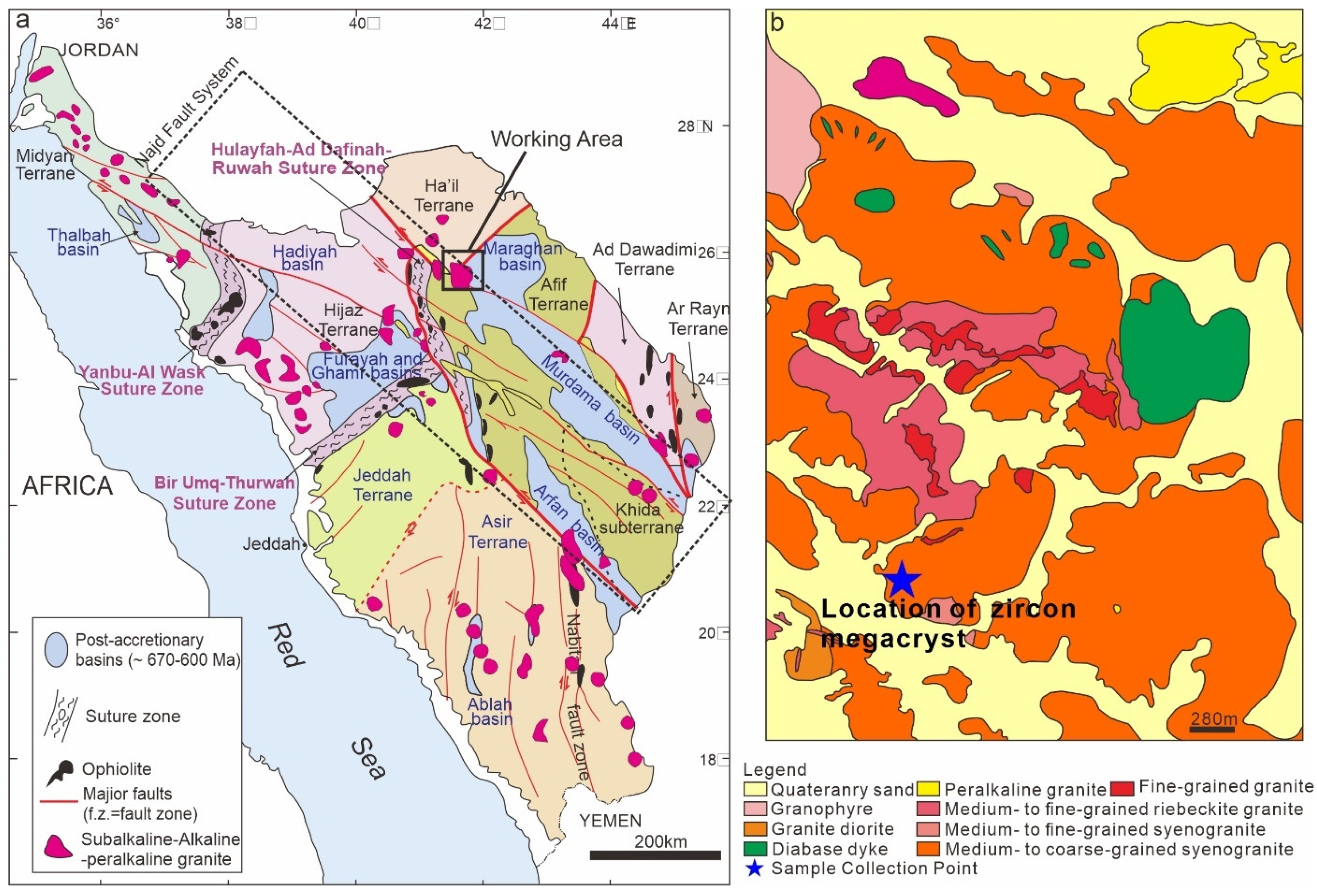
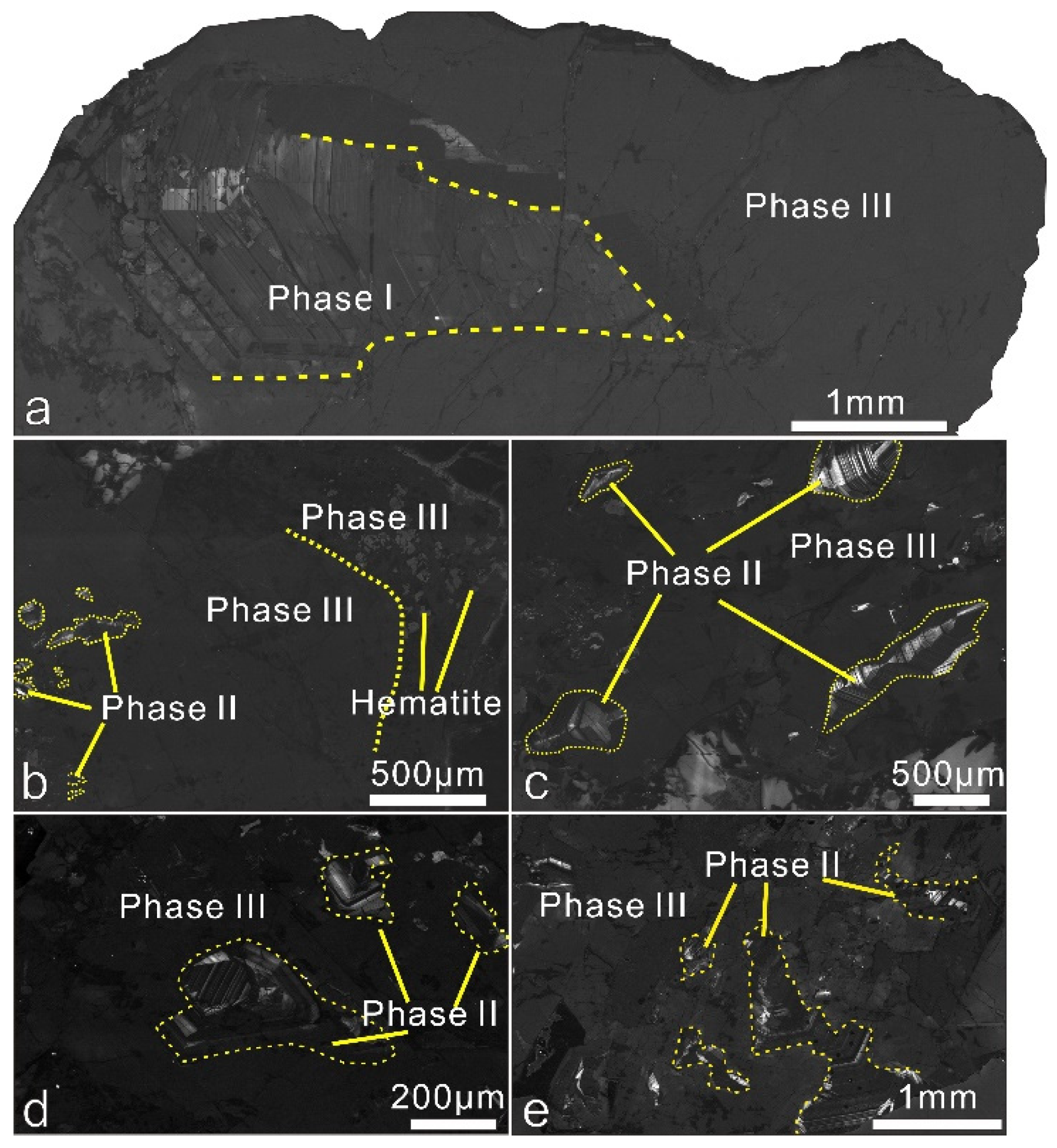


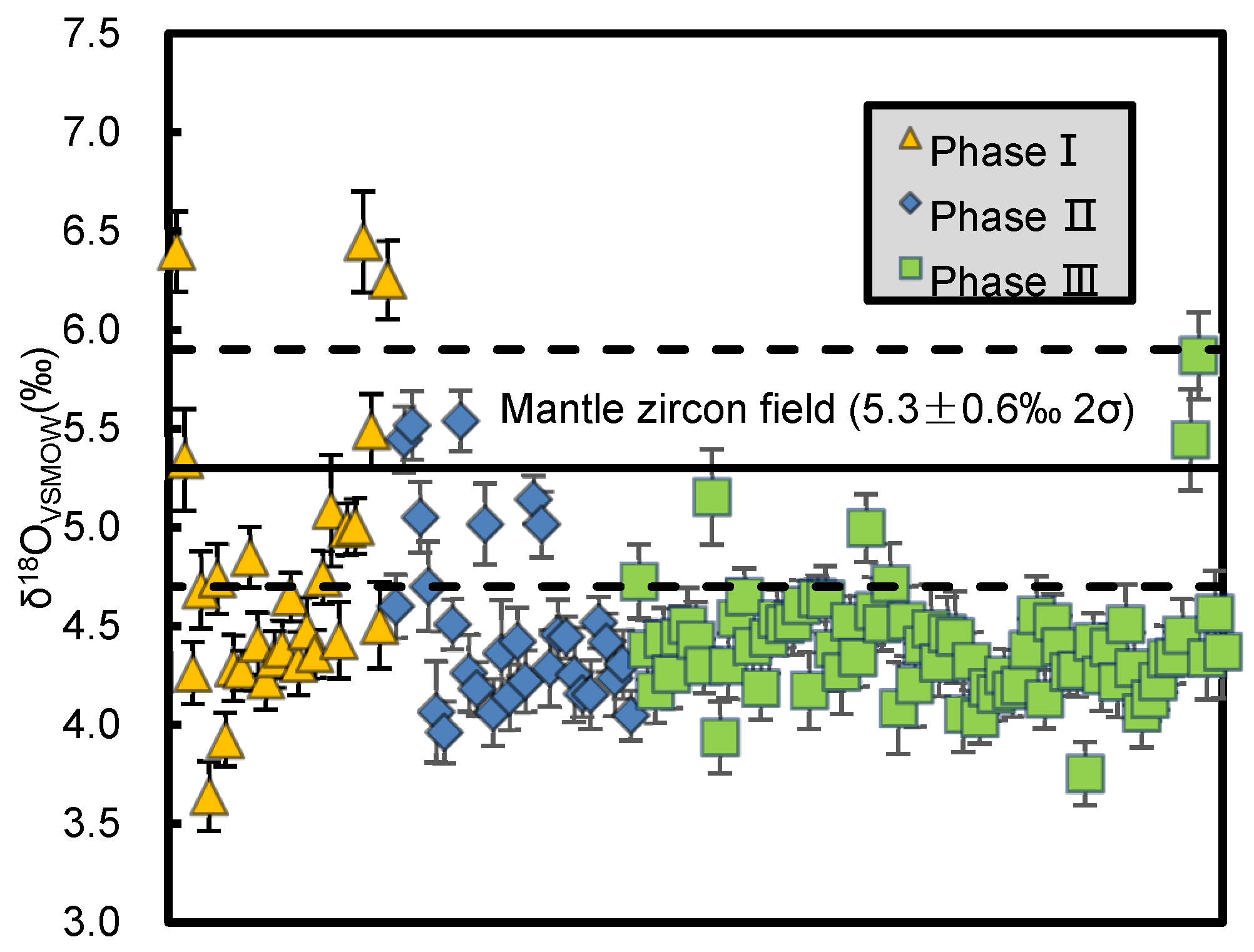
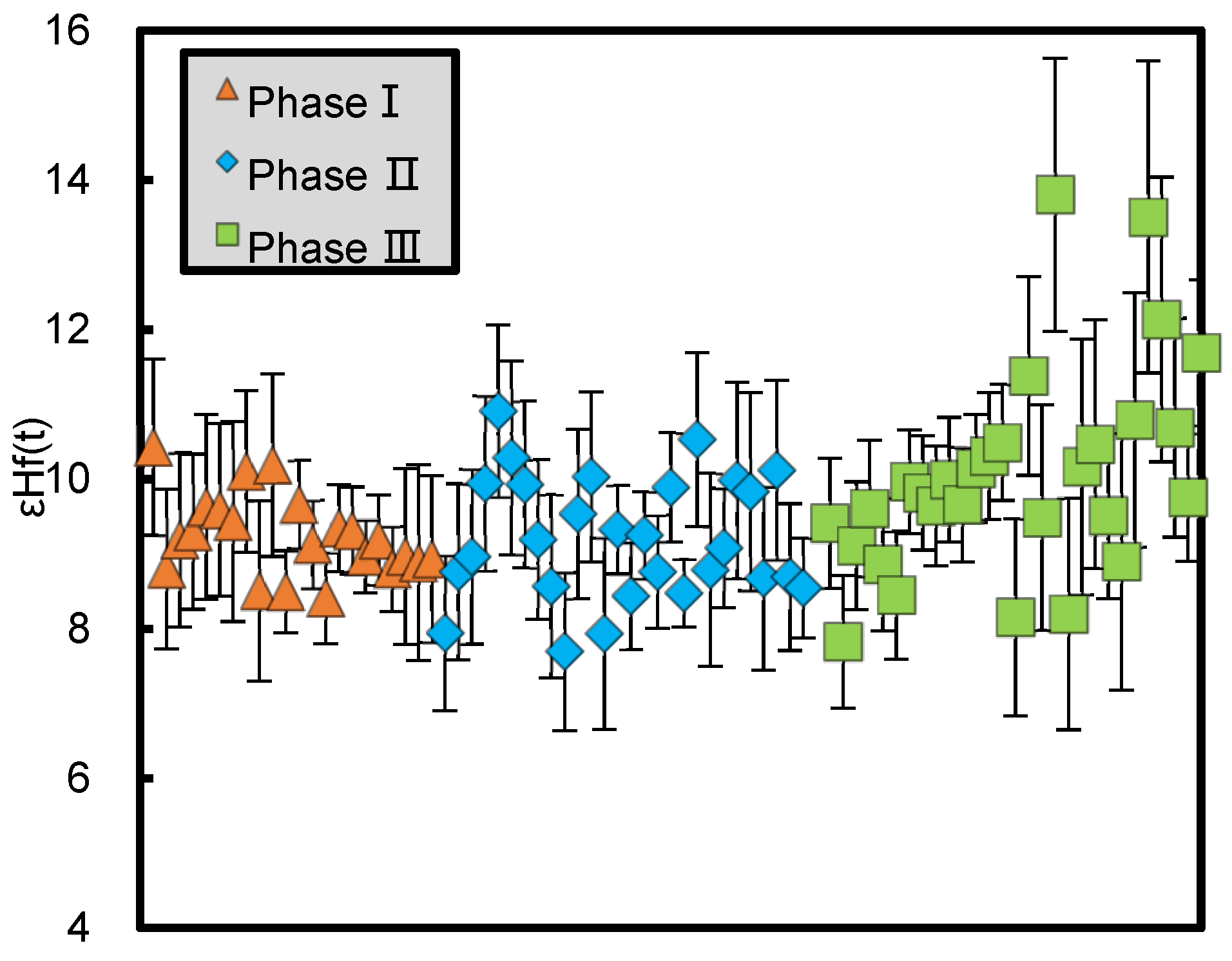
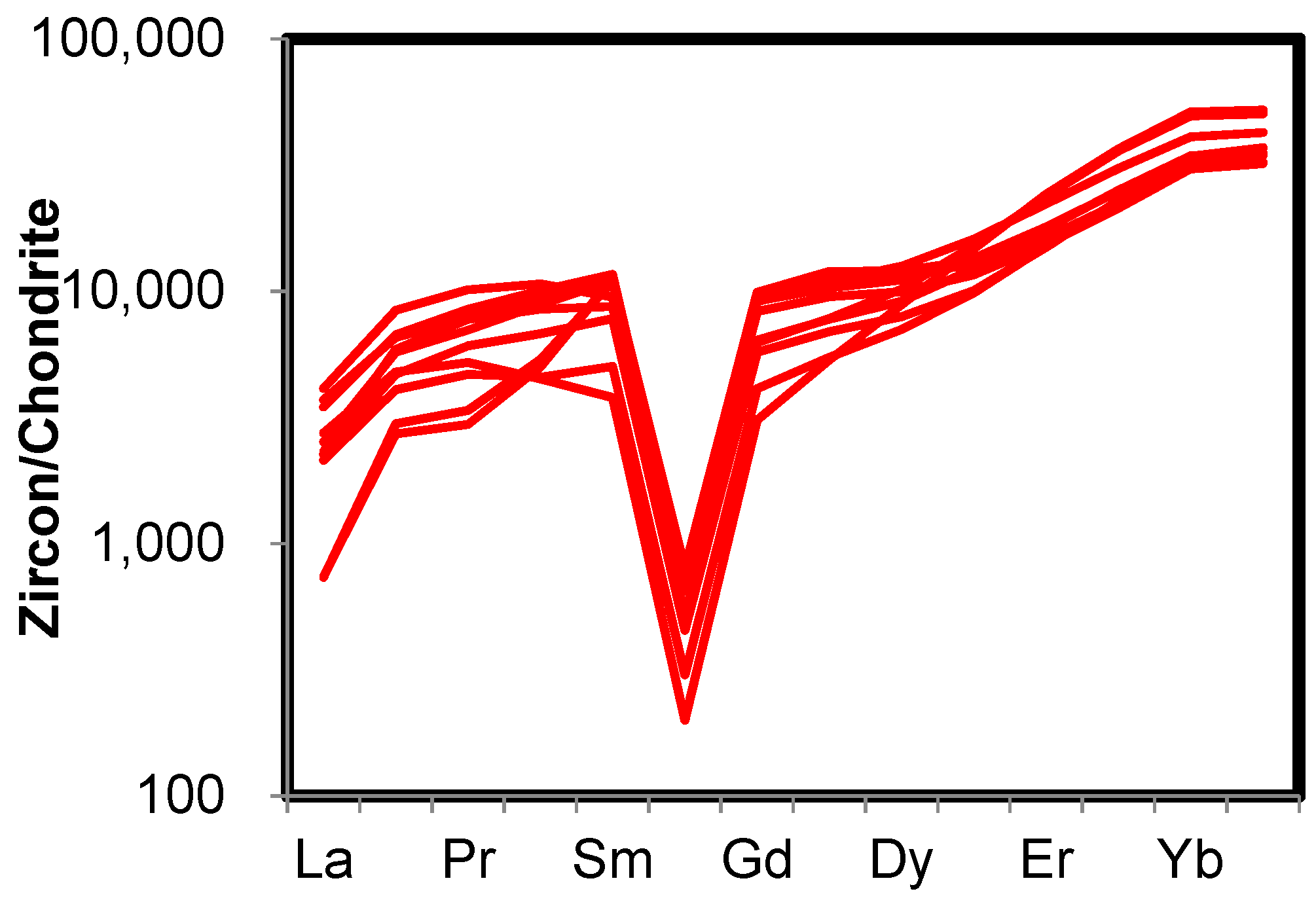
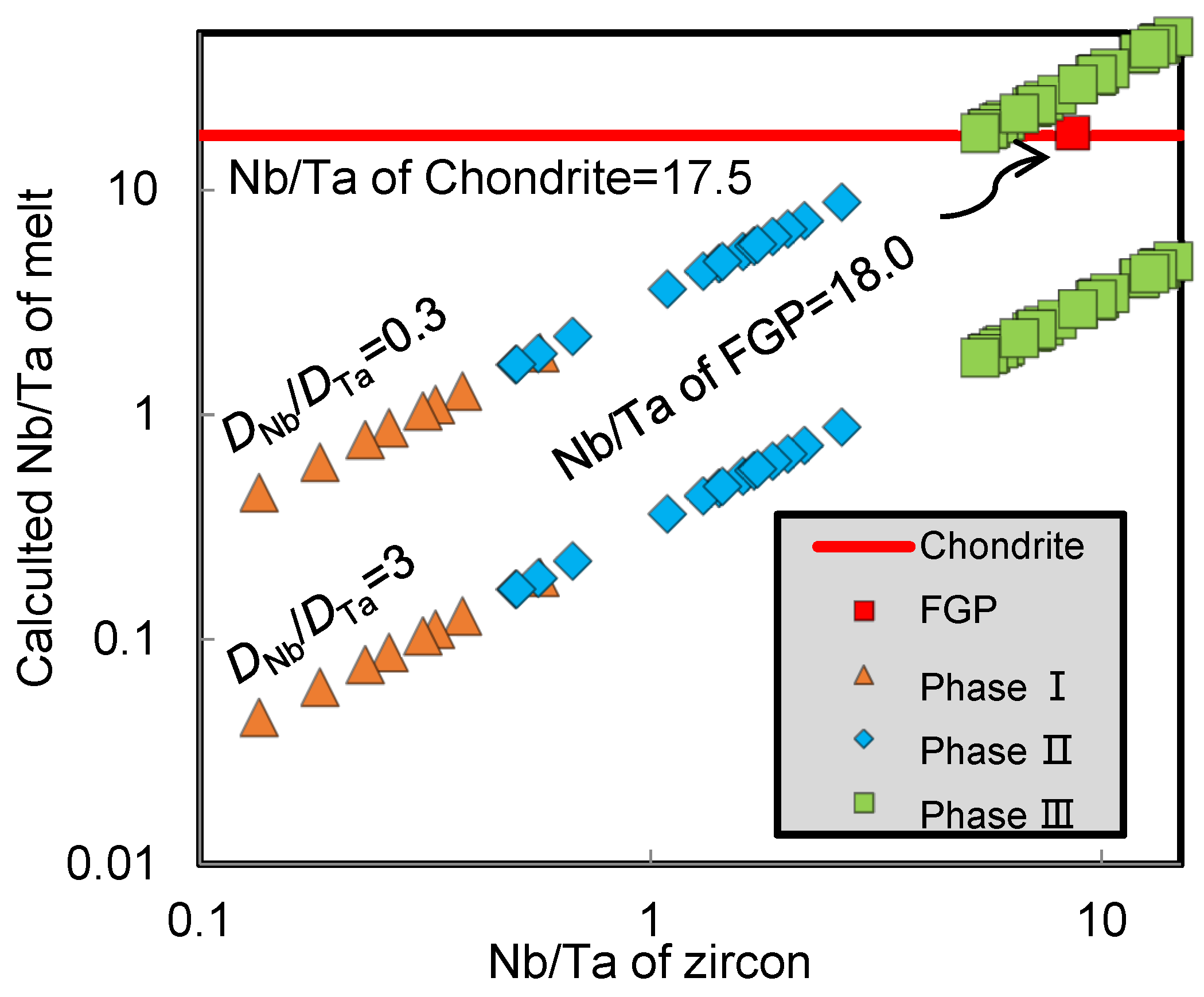

Publisher’s Note: MDPI stays neutral with regard to jurisdictional claims in published maps and institutional affiliations. |
© 2021 by the authors. Licensee MDPI, Basel, Switzerland. This article is an open access article distributed under the terms and conditions of the Creative Commons Attribution (CC BY) license (https://creativecommons.org/licenses/by/4.0/).
Share and Cite
He, S.; Li, Z.; Jehani, A.A.; Guo, D.; Harbi, Z.; Zhang, Y. Nb–Ta Behaviour during Magma-to-Pegmatite Transformation Process: Record from Zircon Megacrysts in Pegmatite. Minerals 2021, 11, 1139. https://doi.org/10.3390/min11101139
He S, Li Z, Jehani AA, Guo D, Harbi Z, Zhang Y. Nb–Ta Behaviour during Magma-to-Pegmatite Transformation Process: Record from Zircon Megacrysts in Pegmatite. Minerals. 2021; 11(10):1139. https://doi.org/10.3390/min11101139
Chicago/Turabian StyleHe, Sheng, Ziying Li, Abdullah Al Jehani, Dongfa Guo, Zaben Harbi, and Yuyan Zhang. 2021. "Nb–Ta Behaviour during Magma-to-Pegmatite Transformation Process: Record from Zircon Megacrysts in Pegmatite" Minerals 11, no. 10: 1139. https://doi.org/10.3390/min11101139
APA StyleHe, S., Li, Z., Jehani, A. A., Guo, D., Harbi, Z., & Zhang, Y. (2021). Nb–Ta Behaviour during Magma-to-Pegmatite Transformation Process: Record from Zircon Megacrysts in Pegmatite. Minerals, 11(10), 1139. https://doi.org/10.3390/min11101139




